The main difference between Rolfing® Structural Integration and therapeutic massage can be found in the goals and focuses of each modality.
The goal of Rolfing is to improve body posture, alignment, and integration of the coordinated working of all the muscles throughout the body’s connective tissue fascial system for optimum functioning and movement in all activities – it is actually more a process than a “technique”.
That said, even if a person’s body seems to be in perfect alignment, Rolfing also brings integration, greater symmetry, and coordinated functioning between all of the tissues, ligaments, tendons and muscles throughout the body. In this way, the tensional forces running throughout the body will not be as likely to become locked up in a tight, tense or compromised area (from stress or injuries, etc.) leading to a potential injury – whether that’s from a normal activity like bending down, stepping down a curve or in actively engaging in some form of exercise or sports activity.
The medium of Rolfing is the connective tissue fascial system matrix that surrounds all the muscles throughout the body and gives the body its structure. This structure either supports – or doesn’t support – the skeleton, soft tissues and organs, positions the bones, determines the direction of muscle pull and movement, and gives the body its shape.
The goal of massage therapy is to generally promote a sense of well-being throughout the musculoskeletal system of the body. If you find the right therapist, massage therapy can be very good for your health.
- Rolfers generally have more technical training in anatomy, physiology and movement than the average massage therapist. Having a throrough understanding of how bodies function makes a huge difference in resolving structural issues.
- Rolfers work strategically along logical, functional, anatomical chains to affect change in the areas that need it the most, rather than doing a full-body routine.
- Rolfers don’t use oil. This allows us to affect the tissues at deeper layers instead of sliding along the surface. Patterns usually live in the deeper layers of tissue.
- Rolfers work slowly and generally use firm, sustained pressure. This allows time for tissues to soften and lengthen.
- Rolfers ask you to participate in the session verbally and through movement. This engages you in the process and ensures that we are giving you exactly what you need.
- Rolfers aren’t focused on giving you immediate pleasure. We are trying to help you find a place of ease and spaciousness that has been lost because of limiting patterns of movement or non-movement.
- The results of Rolfing Structural Integration will occur immediately during the session and progress outside of the session as the connective tissue fascial system continues to integrate throughout your body in your own movement and activity. The outcome & benefits will manifest as long-term results!
________________________________________________________________________________________
Rolfing® and Rolfer™ are service marks of the Rolf Institute® of Structural Integration
